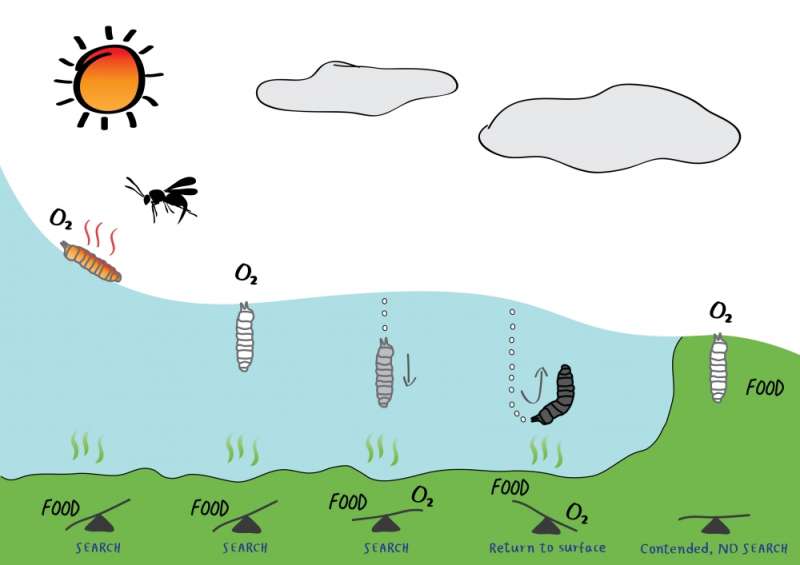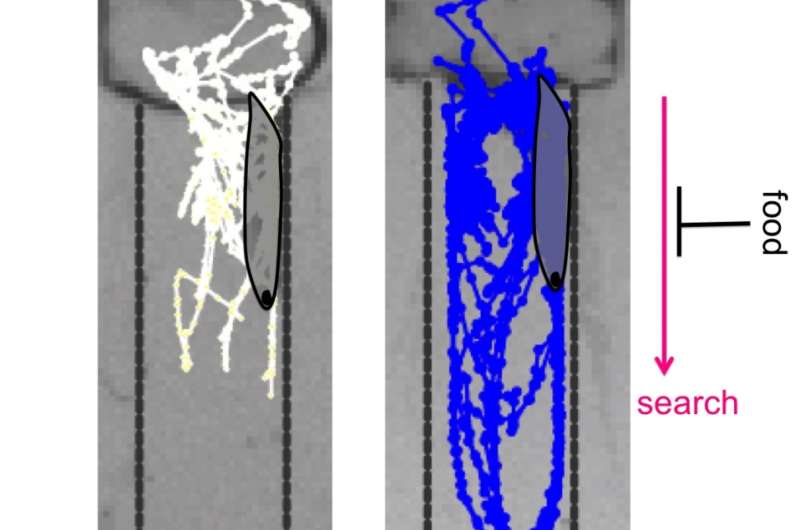Biologists show that fruit fly larvae can make decisions about feeding that balance risk against benefit

We humans aren't the only creatures drawn by the smell of a good meal. Fruit fly larvae, it turns out, are equally susceptible to food scents, although the odors that attract them may not appeal to us.
Drosophila melanogaster larvae must gain an enormous amount of weight very quickly to become fully developed fruit flies, so finding food is a high priority—one that motivates their behavior despite any potential risks.
Knowing these larvae respond to odors but not fully understanding the process by which they make decisions via olfactory cues, scientists at UC Santa Barbara are using this model organism to study brain function as it relates to behavior control.
Seeking to improve that mechanistic understanding, the UCSB researchers and colleagues from the Centre for Genomic Regulation (CRG) in Barcelona turned to the Catalan Institute of Nanoscience and Nanotechnology. Asking Catalan engineers to build a vivarium based on microfluidics in which to observe fruit fly larvae feeding behavior, the scientists demonstrated in subsequent experiments that D. melanogaster larvae are capable of making decisions that balance risk against benefit in the context of their food search. The team's findings appear in the journal eLife.
"Larvae have relatively simple brains compared to vertebrates, which make them good candidates for study," said corresponding author Matthieu Louis, an assistant professor in UCSB's Department of Molecular, Cellular, and Developmental Biology. "We wanted to explore the capabilities of these larvae in naturalistic conditions. We know they have a tendency to move toward food when there's an attractive odor, so we designed the vivarium to mimic the conditions of decaying fruit, larvae's favorite meal."
The transparent chamber contains agarose, a hydrogel with a texture that can be adjusted to various degrees of "hardness." The larvae are introduced at the surface of the gel, and when it's not too hard, they dig, an instinctual behavior that helps them avoid predator wasps and sunlight, which can dehydrate them.
The cylindrical bodies of the larvae are oriented head down, and they use two breathing tubes to stay oxygenated below the surface. If yeast or sugar has been mixed with the agarose, they stay close to the surface of the hydrogel. In the absence of food, they modify their behavior.

"If the hydrogel contains no food but we add a food cue at the bottom of the chamber, the larvae dive deeper and more frequently," said lead author Daeyeon Kim, who conducted this research at the CRG and is now a postdoctoral fellow at UCSB. "In fact, they can go deeper for quite a long time before returning to the surface to breathe. However, this diving behavior is suppressed when the agarose contains food. Then they just stay at the surface and keep eating the substrate."
Diving is the larvae's food search behavior. If they're desperately hungry at the surface, they start exploring the rest of the vivarium, even though descending into the hydrogel means a lack of oxygen. The researchers wanted to know if they could motivate the larvae to dive more frequently despite this risk. And they discovered they could.
"This is interesting because the larvae are exhibiting risky behavior," Louis said. "In fact, we showed that larvae die if they fail to return to the surface when the substrate is too liquid and low friction hampers their locomotion. Thus, diving entails the risk of drowning. Having observed this behavior and shown that odors make larvae overcome their natural tendency to moderate the risk associated with searching for food, we want to understand the brain areas involved in this process of balancing cost and benefit. That will be work for the future now that we've characterized their digging and diving behavior in detail."
As part of the same study, the investigators also examined a fruit pest from the same family, D. suzukii. Capable of attacking fresh fruit, this species uses an ovipositor to pierce berries and cherries and deposit eggs that eventually turn crops into an unappealing puree. To date, no effective insecticides or management techniques are available to control these crop pests.
In this second experiment, the team modified the hydrogel to mimic the harder surface of fresh fruit and found that D. suzukii could dig more and dive longer than D. melanogaster. Their findings indicate that this pest species is better adapted to hypoxic conditions.
The investigators also found an organic compound that acted as a deterrent to D. suzukii: geosmin, which is produced by microorganisms. Geosmin was so repellent to this species that the larvae not only suppressed their diving behavior but escaped the vivarium by squeezing through shallow air channels only 200 micrometers in diameter.
"Geosmin is probably not the odor people will want to use in the future to try to create some kind of repellent for D. suzukii," Louis said. "It smells like wet soil, an odor you probably don't want on your strawberry. But we have provided a proof of concept that the vivarium could be used to test other substances that one day may lead to an effective solution to manage these crop pests."
More information: Daeyeon Kim et al. Species-specific modulation of food-search behavior by respiration and chemosensation in Drosophila larvae, eLife (2017). DOI: 10.7554/eLife.27057
Journal information: eLife
Provided by University of California - Santa Barbara




















